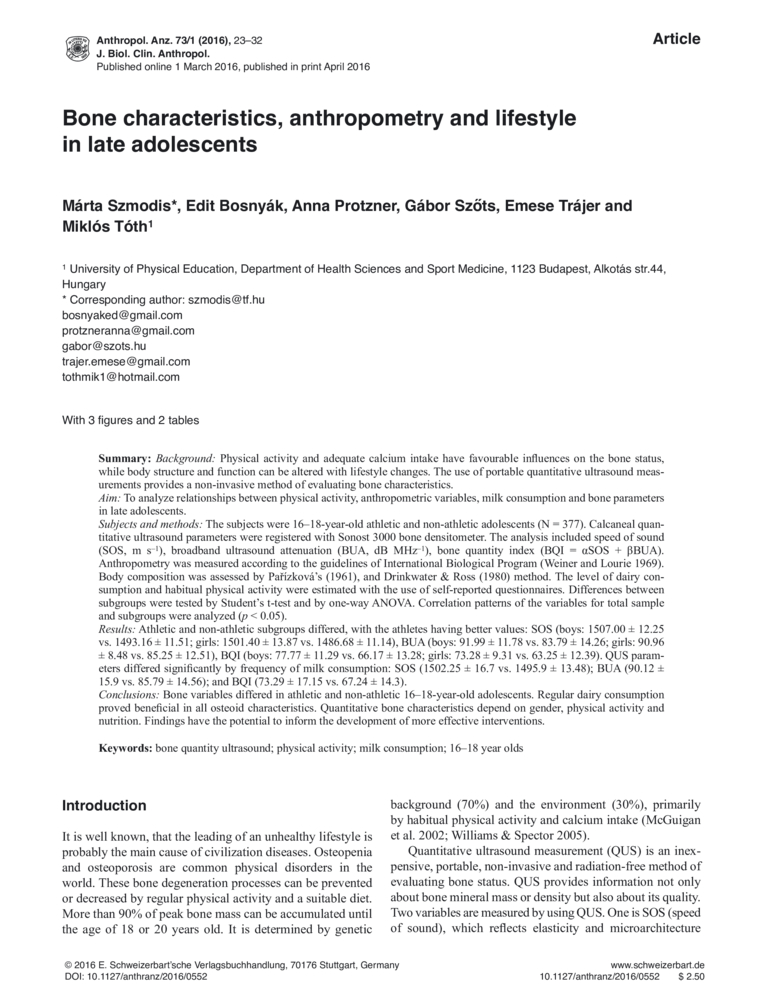Original paper
Bone characteristics, anthropometry and lifestyle in late adolescents
Szmodis, Márta; Bosnyák, Edit; Protzner, Anna; Szőts, Gábor; Trájer, Emese; Tóth, Miklós

Anthropologischer Anzeiger Volume 73 No. 1 (2016), p. 23 - 32
published: Apr 1, 2016
published online: Mar 1, 2016
manuscript accepted: Feb 23, 2015
manuscript received: Nov 15, 2014
DOI: 10.1127/anthranz/2016/0552
ArtNo. ESP140007301003, Price: 29.00 €
Abstract
Summary Background: Physical activity and adequate calcium intake have favourable influences on the bone status, while body structure and function can be altered with lifestyle changes. The use of portable quantitative ultrasound measurements provides a non-invasive method of evaluating bone characteristics. Aim: To analyze relationships between physical activity, anthropometric variables, milk consumption and bone parameters in late adolescents. Subjects and methods: The subjects were 16–18-year-old athletic and non-athletic adolescents (N = 377). Calcaneal quantitative ultrasound parameters were registered with Sonost 3000 bone densitometer. The analysis included speed of sound (SOS, m s–1), broadband ultrasound attenuation (BUA, dB MHz–1), bone quantity index (BQI = αSOS + βBUA). Anthropometry was measured according to the guidelines of International Biological Program (Weiner and Lourie 1969). Body composition was assessed by Pařízková’s (1961), and Drinkwater & Ross (1980) method. The level of dairy consumption and habitual physical activity were estimated with the use of self-reported questionnaires. Differences between subgroups were tested by Student’s t-test and by one-way ANOVA. Correlation patterns of the variables for total sample and subgroups were analyzed (p < 0.05). Results: Athletic and non-athletic subgroups differed, with the athletes having better values: SOS (boys: 1507.00 ± 12.25 vs. 1493.16 ± 11.51; girls: 1501.40 ± 13.87 vs. 1486.68 ± 11.14), BUA (boys: 91.99 ± 11.78 vs. 83.79 ± 14.26; girls: 90.96 ± 8.48 vs. 85.25 ± 12.51), BQI (boys: 77.77 ± 11.29 vs. 66.17 ± 13.28; girls: 73.28 ± 9.31 vs. 63.25 ± 12.39). QUS parameters differed significantly by frequency of milk consumption: SOS (1502.25 ± 16.7 vs. 1495.9 ± 13.48); BUA (90.12 ± 15.9 vs. 85.79 ± 14.56); and BQI (73.29 ± 17.15 vs. 67.24 ± 14.3). Conclusions: Bone variables differed in athletic and non-athletic 16–18-year-old adolescents. Regular dairy consumption proved beneficial in all osteoid characteristics. Quantitative bone characteristics depend on gender, physical activity and nutrition. Findings have the potential to inform the development of more effective interventions.
Keywords
bone quantity ultrasound • physical activity • milk consumption • 16–18 year olds